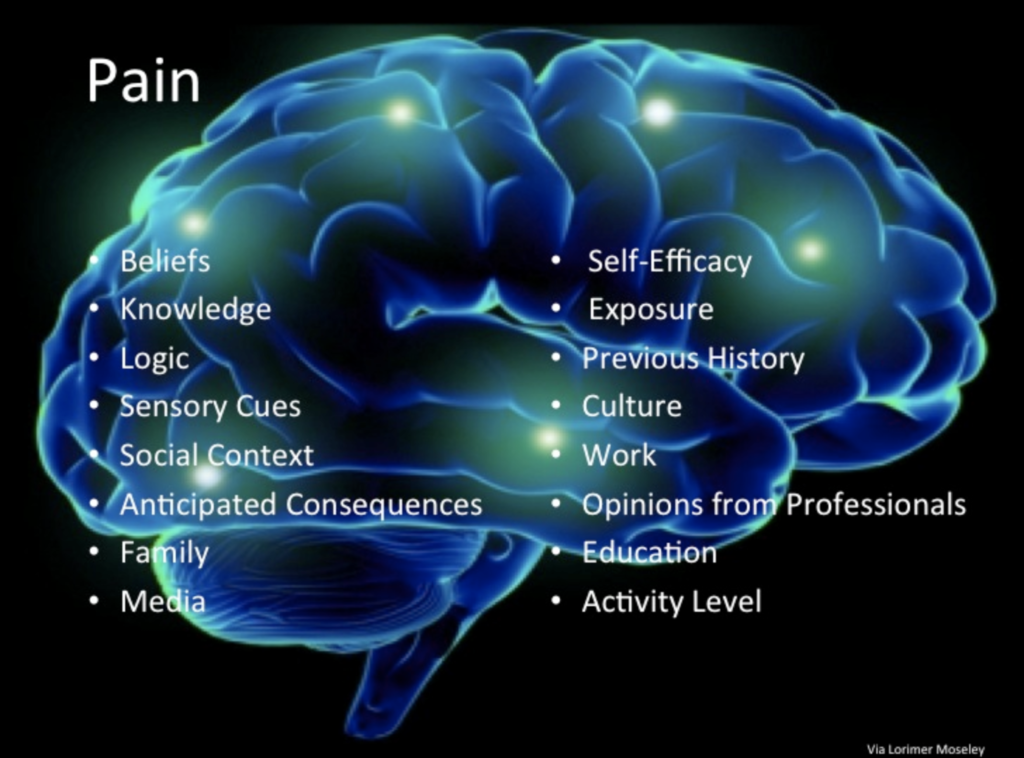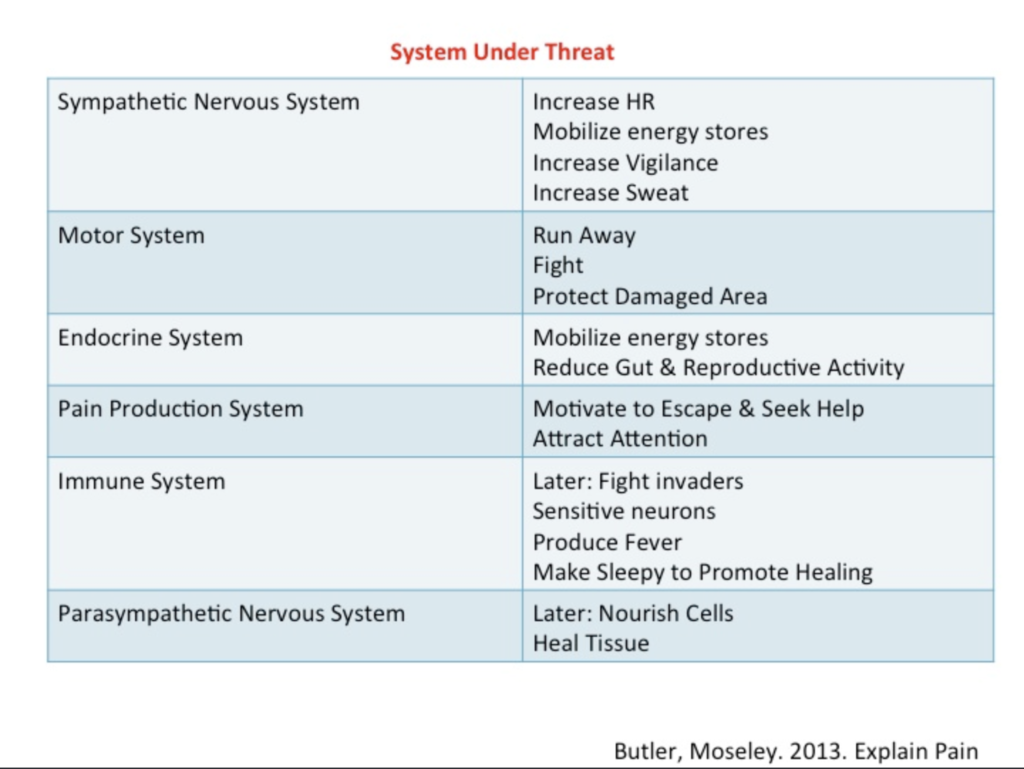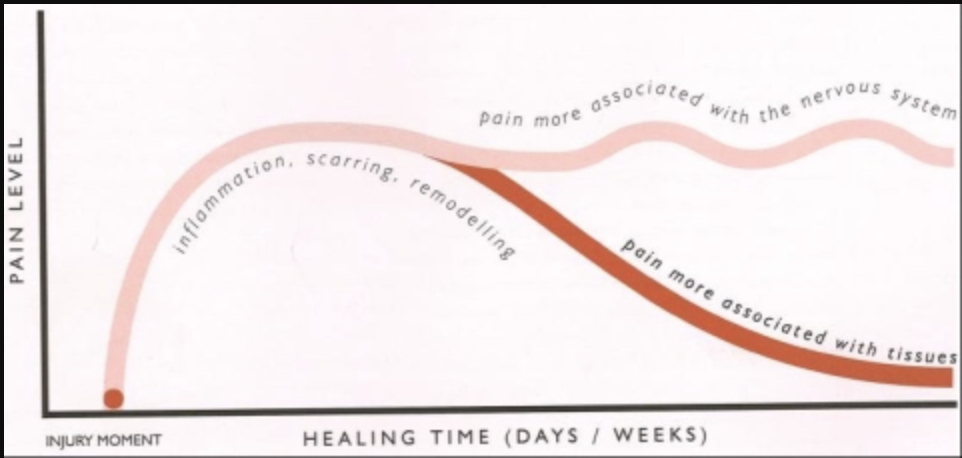At some point in your life, you most likely have experienced pain. Maybe it only lasted a few minutes or hours, or possibly days, weeks, or even years. You may have strained a muscle during your last sprinting session, or rolled an ankle in a pick-up basketball game. You may have even injured your back years ago deadlifting, and it hasn’t been the same since.
Pain can be frustrating and confusing. It can leave you feeling hopeless, consume much of who you are, and prevent you from doing the things you love or once loved.
If you Google “pain relief” you’ll quickly get 181,000,000 results that vary from medication and topical cream, to electronic devices and various stretches. Deciding the best course of action to take can be overwhelming and expensive.
Knowledge is power. And understanding what is igniting your pain may be the first step towards getting back under the bar, on the field, or doing whatever it is you are passionate about.
Pain Protects You
Pain protects you and alerts you to danger, often before you are injured. It can make you move, think, and behave differently. Whether you like it or not, pain is vital for healing.
It is actually really sensible to hurt. Various systems in your body serve as one big alarm that alerts your brain of actual or potential tissue damage. When your body is under threat you may experience pain.
Pain and your body is a lot like Kevin McCallister protecting his house.

And instead of the wet bandits, you deal with many sensory inputs that serve as threats to you and your body.
It’s also important to understand the amount of pain you experience doesn’t necessarily relate to the amount of tissue damage. Your brain is constantly receiving sensory cues and inputs, and has the final say on whether something hurts 100% of the time.

To get a better appreciation for how significant a role your brain plays in pain, it’s powerful to understand context and emotional stress:
- A cut on the index finger of a baseball pitcher may be much more painful than a cut on the index finger of a sweeper on the soccer team.
- The loss of a loved one, a bad break-up, or taking on more responsibility at work can increase both muscle tension and pain.
- You have the power to take control and inhibit your alarm system.
Understanding Your Danger Alarm System


Now that you recognize your brain is the boss and has the final say in pain, it’s also valuable to know that pain is NOT all in your head. There are specific physiological processes occurring that lead to pain.
Mechanical, chemical, and temperature sensors all tell your brain about changes in your body’s tissues, and your thoughts and beliefs are constantly influencing how you perceive these inputs.
After your brain takes into account all of the available information, it quickly decides if any of these sensors are sending danger signals. If so, pain is produced.
The first important piece to appreciate about your danger alarm system is that sensors have an incredibly short lifespan of only a few days. Therefore, your current level of sensitivity is not fixed.
If you can reduce the demands for the production of that particular sensor(s), you’ll reduce the rate of sensor manufacturing, and in return, reduce sensitivity.
This may mean:
- Inhibition of particular muscle chains
- Decreasing sympathetic nervous system activity
- Decreasing daily mental and emotional stress
- Improving exercise technique
- Eating an anti-inflammatory diet
So, how does sensor and sensor activity relate to pain?
We don’t actually have pain receptors, but we do have nocioceptors.
Nocioceptors respond to everything. If something is potentially dangerous to your tissues, they’ll send a signal to your spinal cord and then your brain.
We have nocioception happening all of the time, but only sometimes does it result in pain.
Wait, what?
Remember: when your brain receives an input it’s weighed with all other inputs and then makes a decision as to whether something hurts or not.
The second important thing to know when talking about your danger alarm system is your brain is constantly changing and creating neurotags.
A neurotag is something that is specific to you, and is very dependent on your past experiences. For example, if you were in a motor vehicle accident, the act alone of getting into a car may be threatening and cause an increase in muscle tension.
Or the longer that you’ve had a particular pain, the better your system gets at producing it. The stronger and larger that pain neurotag becomes and the easier it is for that particular pain to be ignited.
Think of your brain like a football team: the longer that you’ve dealt with your pain, the better your team gets at running your pain play. Your running back may work extra-hard and your offensive line may become lazy. Before you know it, your offense loses variability and can only run one play.
No team wins only running one play. You must teach your offense to be curious, creative, and run a variety of plays; this is when your danger alarm system can be shut off.
Learning to drop off these neurotags and replace them with better references can be extremely valuable.
Tissue Damage
Because your danger alarm system is in place to protect the tissues of your body, it’s important to discuss what is happening locally, at specific tissues, that causes your brain to tell you to hurt.
In the case of an acute injury, your aim must be to return the injured tissue to a functional state as QUICKLY AS POSSIBLE. Sometimes rest is best, sometimes movement is needed, other times you may need to intervene via diet, drugs, or surgery.
Pain is sensed via tissues because of inflammation, slow healing, or the tissues become unfit and unused. Movement and massage become important tools for moving tissues and sending safe impulses to your brain to help it construct positive outputs.
All tissues have a healing time, and once the healing time has passed, your tissues don’t get another chance. Managing tissues initially involved in an injury will help manage your pain down the road.
Altered Central Nervous System Alarms

Tissues that don’t heal properly can alter the processes of your highly adaptable central nervous system.
Remember: your brain is the command center of your entire alarm system and makes the final decision as to whether or not you are in pain. When dealing with continual impulses from weak, scarred, inflamed, or acidic tissues, your neurons and spinal cord adapt to meet the consistent demand.
At the dorsal root ganglion (DRG), a bulge before your peripheral nerve enters your spinal cord; messages from your tissues undergo some evaluation. Your DRG is sensitive and changeable and may send inaccurate signals to your brain, like telling it there is more tissue damage than there actually is.
Your DRG is also vulnerable to hormonal and chemical changes in your blood when you are stressed, which can cause signals that shouldn’t be perceived as dangerous as threatening.
The better your spinal cord gets at sending this danger message to your brain, the more sensitive your alarm system becomes.
When your alarm system becomes more sensitive Kevin McCallister has to go from setting up a few Christmas ornaments on the floor to installing a super alarm system with infrared and motion detectors. Now any little input will trip the system.
Signs and symptoms of a sensitized central alarm system (an offense stuck running one play) include:
- Persisting pain
- Pain that is spreading
- Pain that is worsening past acute phase
- Lots of movements (even small ones) hurt
- Pain is unpredictable
- Other threats in life: previous, current, and anticipated
When your nervous system is continually in fight or flight mode, your brain is priming your muscles accordingly. Big boys like your erector spinae, lats, quads, and pecs are always on.
These long-term motor changes make you behave differently, hold yourself differently, and even talk differently. It can be challenging to reverse these learned patterns.
Taking Control
Step 1: Understand and Educate
If you’ve made it all the way here, you’ve already begun taking control. Developing an understanding and educating yourself about the physiology of pain can reduce the amount of threat you feel.
REDUCED THREAT HAS A POSITIVE EFFECT ON ALL THE INPUT AND RESPONSE SYSTEMS.
Many of us don’t like not knowing, and knowledge can be powerful in helping reduce the hurt you feel.
Step 2: Identify Ignition Cues
Much of the article educated you on sensory inputs that inform your brain of threat. Discovering what these inputs, or pain ignition cues, are is what will set the stage for active strategies you’ll implement to inhibit your danger alarm system.
These inputs can come from many different sensory cues and scenarios. They vary from overactive chains of muscle at your pelvis, thorax, or cranium. Or could even come from your vision or feet.
Non-physical ignition cues that are often forgotten include mental and emotional stressors, or a poor diet.
If you go to a health-care professional to help you identify your ignition cues, it’s important that they can answer all of your questions, and make clinical decisions based on your particular presentation and objective tests that he goes over with you.
Step 3: Learn Active Coping Strategies
With your ignition cues identified, you can now go about implementing active coping strategies. These may include:
- Learning about the problem
- Exploring ways to move
- Exploring and nudging the edges of pain
- Staying positive and establishing a supportive and enthusiastic team around you
- Making plans
- Finding de-stressing activities
Step 4: Your Hurts Won’t Hurt You
Once you begin to use active coping strategies, remind yourself that hurt doesn’t always equal harm.
Step 5: Pacing and Graded Exposure
Your nervous system needs you to gradually increase your activity level. Be patience and persistent.
- Choose an activity your want to or need to do more of
- Find your baseline
- Plan your progression
- Don’t flare up, but don’t freak out if you do
- Look at the whole picture. Stressors come from various places in your life
Much of this article touches on what happens when pain persists long past the time it takes for tissues to heal.
If you’ve recently had an injury, remember to manage your tissues and manage other stressors in life, like getting better sleep, better nutrition, and making time for things like meditation.
If your pain has been persistent and worsening, think about what happens when your nervous system becomes sensitized and you install your super alarm system. Learn active coping strategies and teach your offense to run new plays.
Be curious, be creative, feel, and find yourself living a much happier and pain free life.
References:
Butler, D., & Moseley, L. (2003). Explain Pain. Adelaide City West, South Australia: Noigroup Publicatinos.

